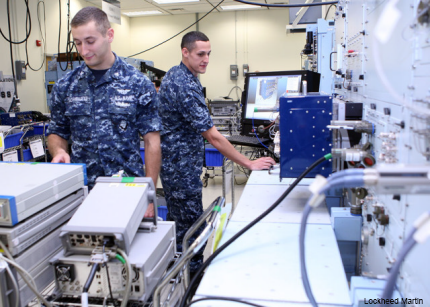Lockheed delivers first of Navy's automated aircraft test systems
The enhanced eCASS will allow aircraft carriers to operate more like airports at sea.

Navy avionics technicians perform diagnostic tests using eCASS at Lockheed Martin’s training site in Orlando, Fla.
Lockheed Martin has delivered to the Navy the first of 36 Electronic Consolidated Automated Support Systems, or eCASS, an upgrade to the CASS test system that has been in use aboard naval vessels and ashore since the early 1990s.
The system is used to test electronics systems on aircraft—ranging from computers and flight controls to radars and laser range finders—and identify and repair problems to ensure the aircraft are flight-ready. The Navy plans to deploy eCASS on all of the fleet’s aircraft carriers and at its Aircraft Intermediate Maintenance Depots. Eventually, up to 341 stations could be deployed.
“eCASS takes automated testing to the next level,” Chris Giggey, deputy program manager for Automatic Test Systems with the Naval Air Systems Command’s Aviation Support Equipment Program Office, said in a conference call with reporters. The system has a much smaller footprint that CASS, he said, runs faster and more reliably, is compatible with legacy CASS equipment, and can connect to the network backbone to allow for upgrades.
It can support more than 750 avionics and electronics components, covering all of the Navy’s aircraft, including newer systems like the F-35 Joint Strike Fighter. The system, built on an open architecture, is expected to accommodate new weapons systems for the nest 30 year, according to Lockheed.
The genesis of the system dates back to a 1979 report to Congress that addressed the costs of testing and repairing aviation electronics, after which the Navy started the CASS program. By repairing electronics at sea or at intermediate depots rather than waiting for a return to port, the Navy could get aircraft back into service a lot faster while saving money.
But while the original CASS was successful, it was getting old and expensive to maintain. A more recent study determined that it could cost $3.8 billion to continue, while replacing it with eCASS would cost $1 billion, and the Navy expects to save $1 billion a year by using the system.
The Navy awarded Lockheed Martin an $83 million contract in March 2010 for eCASS development, and a $103 million contract in January 2014 for low-rate initial production.
The new system, which will come in the form of one core system with five different mission equipment kits, takes up three 19-inch racks for basic testing and four racks for its other missions, as opposed to the five to seven racks taken up by CASS, Giggey said.
That makes a difference even on something as large as an aircraft carrier, where space for equipment still comes at a premium, said Capt. Brian Jacobs of the Naval Air Systems Command. eCASS lets a carrier operate more completely as an airport at sea, he said, being more reliable, sustainable, portable and energy-efficient that its predecessor.




